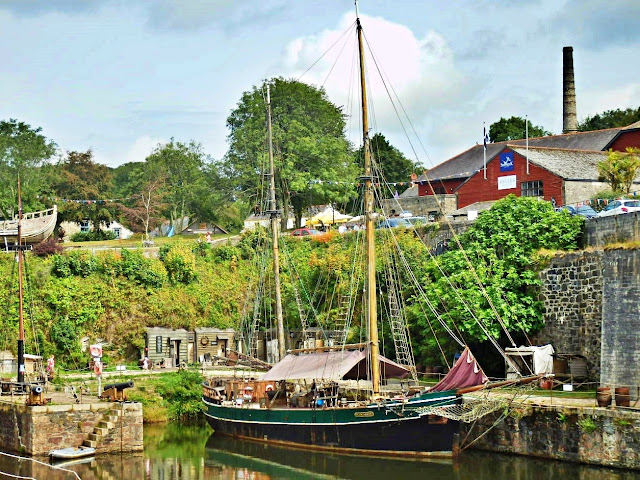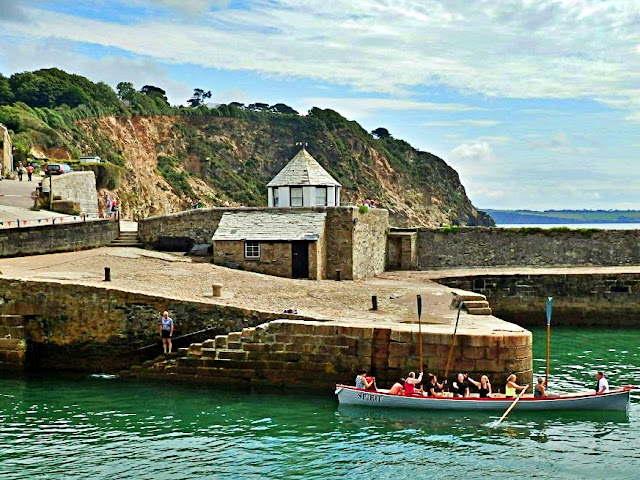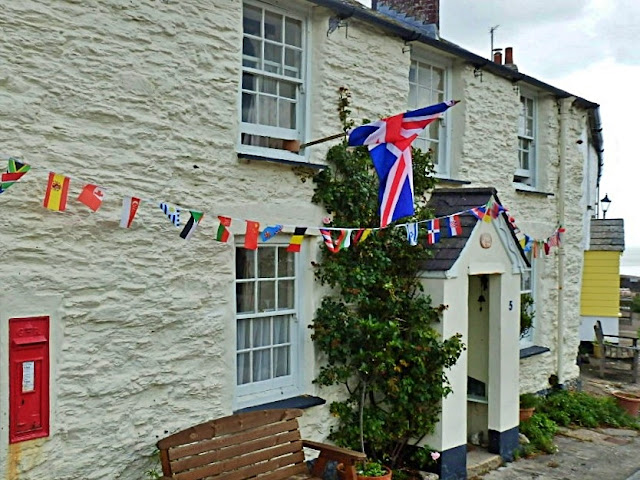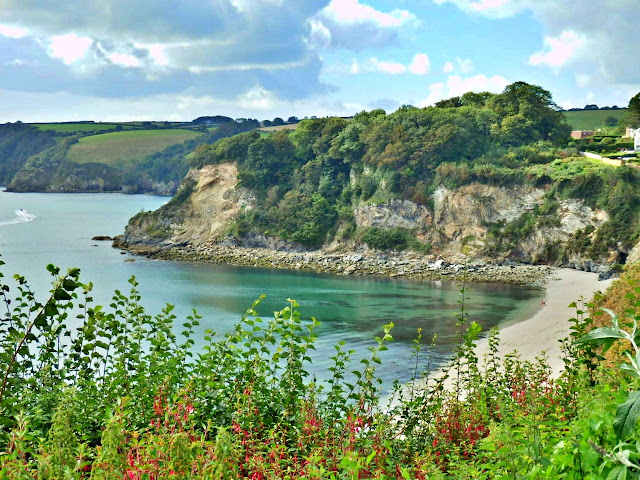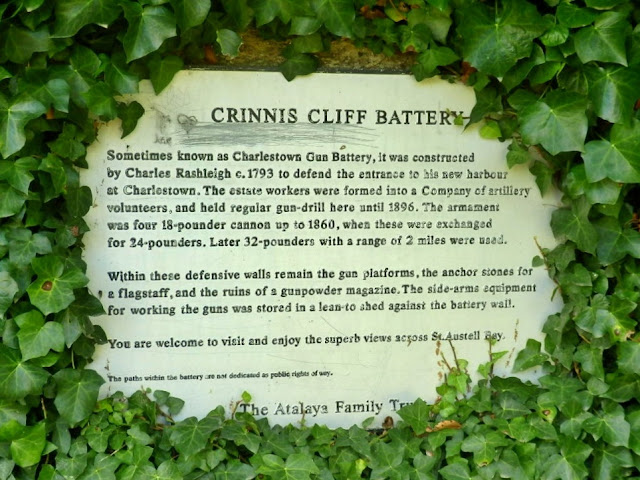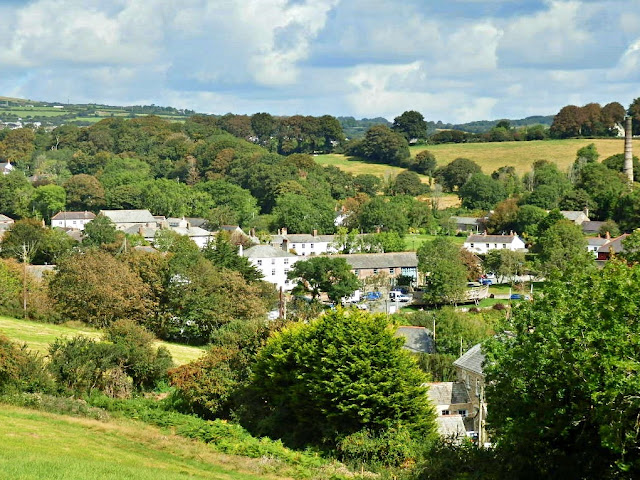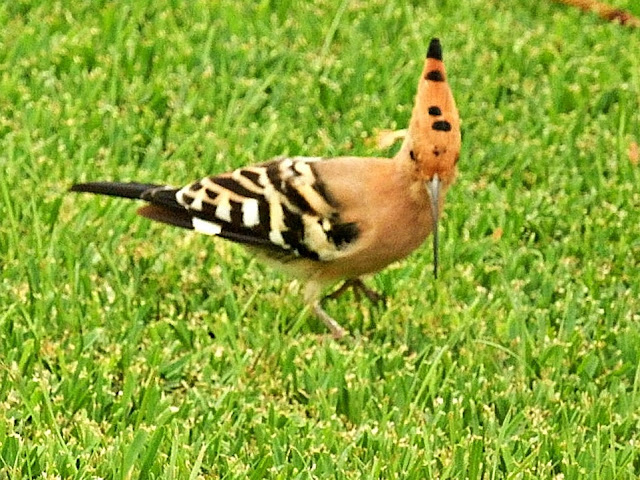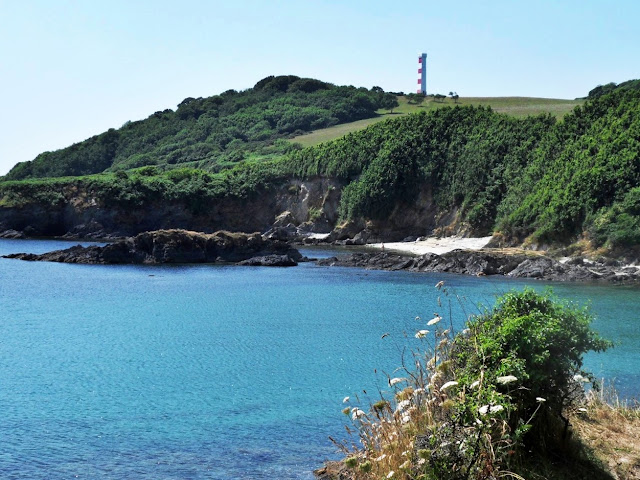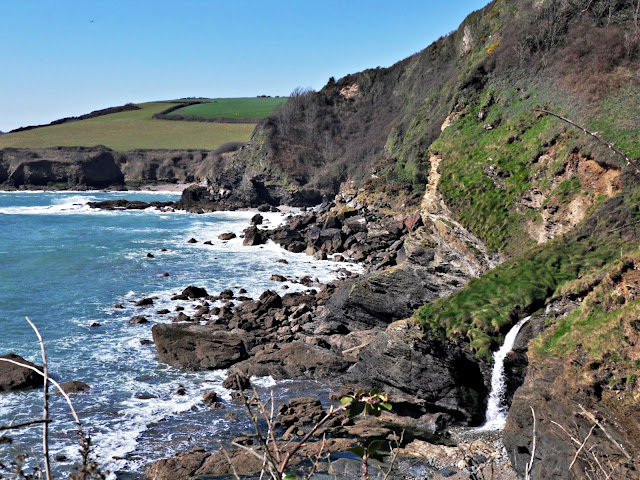Sunday, 29 September 2019
A Quiet Stroll Around Charlestown Harbour, Cornwall and Poldark's Sailing Ship
I recently published a post Charlestown, Cornwall With Sailing Ships In The Harbour but the harbour isn't always full of ships, as can be seen in today's post.
The photo above shows just one sailing ship - but it is a popular one, as it has featured in the popular Poldark television series.
Below is the narrow bridge across the narrowest part of Charlestown Harbour.
The next photo shows some of the old cottages looking down on the harbour. Several of them are now rented out to holiday makers.
All quiet, other than the Charlestown Rowing Club returning.
Only one boat moored temporarily in the harbour.
More cottages and the flags are out, though the Union Flag has got into a bit of a tangle.
And a row of terraced cottages - this time with Cornwall's St.Piran's flags on display.
Finally some movement as a small craft returns to the harbour.
I like Charlestown at any time of year. I have no doubt mentioned this before, but we chose to visit here on the first morning of the new millennium. It was foggy and damp but, looking back from the harbour wall, with no one else about, it was like stepping back in time to the late 1700s. Who says time travel isn't possible!
Thursday, 26 September 2019
Walking From Duporth Beach to Charlestown, Cornwall.
Above is Duporth beach, which can only be accessed from Cornwall's coastal path - this entails a walk, either from Porthpean or Charlestown.
The photos are in sequence from the beach and heading towards Charlestown.
The beach itself is gently sloping and a mixture of sand and shingle. The name Duporth means two coves in the Cornish language. On some maps it is shown as 'Du Porth.'
Probably needless to say, but there are no facilities - toilets etc - on the beach.
The coastal path is quite easy to walk though there are inevitable ups and downs. Backing on to the path, by the beach, are several modern housing estates which have access to the beach.
The site for the estates was previously a holiday seaside camp and was used during World War 2 as accommodation for American and Indian troops. After the war it became a holiday camp once more - until it was sold for housing.
As you walk along the coastal path towards Charlestown there are some historical remains such as the Crinnis Cliff Battery as described in the notice below. I'll reprint the wording just in case you are using a small screen:
CRINNIS CLIFF BATTERY:
Sometimes known as Charlestown Gun Battery, it was constructed by Charles Raleigh c.1792 to defend the entrance to his new harbour at Charlestown. The estate workers were formed into a Company of artillery volunteers, and held regular gun-drill here until 1896. The armament was four 18-pounder cannon up to 1860 when these were exchanged for 24-pounders. Later 32-pounders with a range of 2 miles were used.
Within these defensive walls remain the gun platforms, the anchor stones for a flagstaff, and the ruins of a gunpowder magazine. The side-arms equipment for working the guns was stored in a lean-to shed against the battery wall.
The mentioned gunpowder magazine is shown below.
The views inland now show the beginnings of Charlestown.
Finally from the cliffs we can see the outer wall of Charlestown Harbour. It's now downhill all the way to Charlestown.
Note: If walking from Porthpean to Charlestown, along the coastal path, the distance is approximately 3 miles.
Monday, 23 September 2019
Charlestown, Cornwall With Sailing Ships In The Harbour
Prior to going on holiday I made a quick visit to Charlestown harbour. I had heard that there were several sailing ships in dock.
I didn't have a lot of time but snapped a few photos as I walked.
There was a stall using the Poldark name to entice people to have a free taster of their various alcoholic drinks - over 18's only, of course. Some of the Poldark scenes were filmed here.
From the harbour wall the masts of the sailing ships looked quite a muddle - but an interesting muddle!
Again, looking from the harbour wall, this time over the small beach. The Charlestown Rowing Club were just returning
One of the rowing boats was also on the harbourside.
By the harbour was another stall selling items made from sea-glass and other treasures found on the beaches.
The cottages look down on the sailing ships from on high.
And, to finish with, a few more sails. It's always interesting wandering around Charlestown Harbour.
Also see:
A Stroll Around Poldark's Charlestown Harbour, Cornwall - 12 Photos
Friday, 20 September 2019
From Cornwall To The Canary Islands
Apologies that there haven't been any Cornwall posts for a short while. I have been away in Lanzarote, Canary Islands.
I have taken the liberty of a publishing a couple of random photos from the island.
The photo above is leaving Exeter, England by plane and below is a view of Lanzarote's volcanic countryside - perhaps not everyone's cup of tea!
I quite like the scenery though, certainly very different from Cornwall.
But there are also some pleasant beaches and ...
… also some very busy beaches - the sort that has no appeal to me, but each to their own taste. I like a bit of elbow room on the beach.
And to finish with a couple of Lanzarote birds.
The one below I believe is a Hoopoe, though I called it an upside down bird.
… because from some angles the bird looks to be upside down!
Anyway, apologies for the lack of Cornwall photos, hopefully normal service will be resumed.
Tuesday, 10 September 2019
Polridmouth, Menabilly, Cornwall - Daphne du Maurier Country, Cornwall
The author Daphne Du Maurier made her home for many years at a large house on the Cornish Menabilly estate - this was the ancestral seat of the Rashleigh family.
The first line of her book, Rebecca, reads "Last night I dreamt I went to Manderley again. It seemed to me I stood by the iron gate leading to the drive …" Manderley is Menabilly.
Her book The King’s General was inspired by the history of Menabilly during the 1600s.
Unfortunately the house cannot be seen by the public, as it is well hidden.
The only photo I have of the Menabilly House is the black and white photo above, showing Daphne Du Maurier and her children.
What can be seen, though, is the cottage and boathouse as shown at the top of this post. This is where Rebecca would entertain her guests and where she was supposedly murdered.
So many of Du Maurier's books are based in this part of Cornwall - it is often referred to as 'DuMaurier country'
The lake, as below, was made in the thirties by damming a small stream. This part of the estate can be clearly seen by walkers or people visiting the small beaches.
During World War Two lights were fixed around the lake to confuse any enemy aircraft. Nearby Fowey was a port used for the build up to the D-Day landings. Over 2,000 American troops were based in the area.
Going back to the cottage, this is by the sea and there are small beaches nearby, notably Polridmouth (pronounced Pridmouth). There aren't normally too many people about.
Along the coast Gribbin Head can be seen and the red and white striped beacon.
In her book,Rebecca, Du Maurier writes:
And I thought of the tide, how swift it ran and strong into the little cove. The wind blew down from the headland like a funnel. I got the boat out into the bay. I got her out there beyond the beacon …"
And below a clearer photo of the daymark Gribbin tower.
I have written before that I love this stretch of coastline.
As for Daphne du Maurier (1907-1989) she moved away from Menabilly in 1965 following her husband's death. She remained in Cornwall, near Par, in a house called Kilmarth - which she used as a setting for her book The House on the Strand.
See more photos of Menabilly:
The Wonderful Coastline At Menabilly - Daphne du Maurier Country
Saturday, 7 September 2019
Who or What are Cornish Knockers?
A further tale from The drolls, traditions, and superstitions of old Cornwall by Robert Hunt (1807 -1887). This tries to explain who are the Knockers, often mentioned in stories of Cornish tin mines. It appears that Charles Kingsley (1819-1875) posed the question: 'Who are the Knockers?' This was the reply:
One Saturday night I had retired to rest, having first seen that all members of the household had gone to their bedrooms. These were my daughters, two female servants and an old woman named Mary, who was left by the proprietor in charge of the house which I occupied.
I had some time in bed when I distinctly heard a bedroom door open and footsteps which, after moving about for some time in the passage or landing, from which the bedrooms opened, slowly and carefully descended the stairs.
I heard a movement in the kitchen below, and the footsteps again ascended the stairs and went into one of the bedrooms. The noise continued so long, and was so regularly repeated that I began to fear lest one of the children were taken suddenly ill. Yet I felt assured, if it was so, one of the servants would call me. Therefore I lay still and listened until I fell asleep.
On the Sunday morning, when I descended to the breakfast-room, I asked the eldest of the two servants what had occasioned so much going up and down stairs in the night. She declared that no one had left their bedrooms after they had retired to them.
I then enquired of the younger girl, and each of my daughters as they made their appearances. No one had left their rooms - they had not heard any noises.
My youngest daughter, who had been after this enquiry of mine for some minutes alone with the youngest servant, came laughing to me.
"Papa, Nancy says the house is haunted and that they often heard strange noises in it."
So I called Nancy; but all I could learn from her was that noises, like men going up and down stairs, of threshing corn and 'beating the borer' (a mining operation) were not uncommon.
We all laughed over papa's ghost during breakfast, and by and by old Mary made her appearance.
"Yes," she said, "it is quite true, as Nancy 'as told you. I have often heard all sorts of strange noises; but I b'lieve they all come from the lode of tin which runs under the house. Wherever there is a lode of tin, you are sure to hear strange noises."
"What, Mary! was it the knockers I heard last night?"
"Yes, 'twas the knockers, down working upon the tin, no doubt of it."
This was followed by a long explanation, and numerous stories of mines in Leland and St. Ives district, in which the knockers had often been heard.
After a little time, Mary, imagining I suppose that the young ladies might not sleep in a house beneath which the knockers were at work, again came with her usual low curtsey into the parlour.
"Beg pardon, sir," says she, "but none of the young ladies need be afraid. There are no spirits in the house; it is very nearly a new one, and no one has ever died in the house."
I have previously touched on the subject of the Knockers on my blog post Knockers, Tin Mines and Cornish Pasties.
Wednesday, 4 September 2019
Cornwall's Coastal Path With Wonderful Year Round Sea Views
"Okay," said this chap I met on a walk, "but Cornwall must be a cold, drab place once the summer sun has gone."
Well no! I'll answer the assumption with today's photos taken on a cold day, out of the holiday season - look at the views! The trees and scrub may be brown but the grass and sea are alive with colour. The light can be so good in Cornwall, it's why artists head this way.
The photos are from a walk starting at the small hamlet of Trenarren on Cornwall's south coast and simply walking along the coastal path, passing Black Head and looking out to sea.
One of the great things about Cornwall is this coastal path stretching around all of the county and beyond. There are no restrictions (unless it is dangerous) it's all a public right of way.
Sure, some of the path can be rough and uneven but at other times there may be wonky steps to make climbing the cliffs easier.
There are ups and downs, of course - such is life - but that makes it all the more interesting.
Looking inland on this particular stretch of path there are farmer's fields, mostly fenced off but at times there are public rights of way across these fields.
Even the cattle appreciate how lucky we are living in Cornwall.
On a cold, clear day what can be better than walking along the coast and breathing in all of that fresh air. Perfect!
P.S. To quote the Geography of Climate:
"Cornwall has a temperate Oceanic climate, with mild winters and cool summers. Cornwall has the mildest and sunniest climate in the United Kingdom, as a result of its oceanic setting and the influence of the Gulf Stream. Winters are amongst the warmest in the country, due to the moderating effects of the warm ocean currents, and frost and snow are very rare at the coast and are also rare in the central upland areas. Cornwall is one of the sunniest areas in the UK, with over 1541 hours of sunshine per year, with the highest average of 7.6 hours of sunshine per day in July."
See also:
South West Coast Path Walking From Trenarren, Cornwall
Subscribe to:
Posts (Atom)
FEATURED POST
Cornwall's Lizard Peninsula
I know my wife and I and live in Cornwall but we had a break away from home on Cornwall's L izard Peninsula - one of our favourit...


